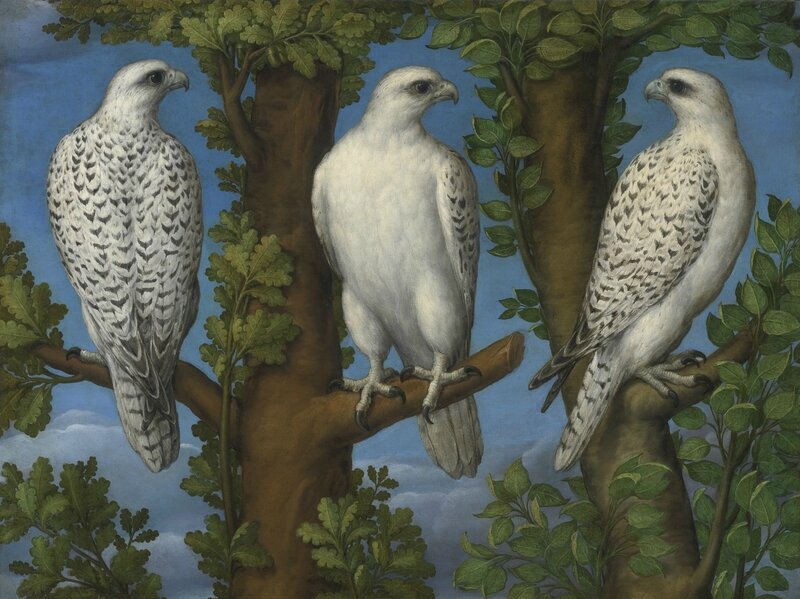Lombard Master, 1540 – 1560, Portrait of a gyrfalcon, viewed from three sides
Lombard Master, 1540 – 1560, Portrait of a gyrfalcon, viewed from three sides. Photo Sotheby's.
oil on canvas, unlined; 29 3/4 by 39 5/8 in.; 75.7 by 100.5 cm. Estimation 700,000 — 1,000,000 USD
Provenance: Adamo Boari (1863 - 1928) collection, (according to tradition of the family in whose possession the painting remained for most of the 20th century);
In a private family collection from the 1920s until circa 2000;
When acquired by the present owner.
Exposition: Milan, Palazzo Reale, Arcimboldo, artista milanese tra Leonardo e Caravaggio, 10 February - 22 May 2011, no. 147.
Litterature: G. Olmi and L. Tongiorni Tomasi, "Raffigurazione della natura e collezionismo enciclopedico nel secondo Cinquecento tra Milano e l'Europa", in Arcimboldo, artista milanese tra Leonardo e Caravaggio, S. Ferino Pagden, ed., exhibition catalogue, Milan 2011, p. 128 and p. 370, cat. no. 147, reproduced p. 131.
The sport of falconry, practiced since ancient times, was a pursuit particularly enjoyed at Medieval and Renaissance courts. The gyrfalcon, shown here, is the largest of the falcon species; the size of the bird, almost certainly painted from life and to scale, suggests it is a female, and the grandeur of the portrait, presenting it from three viewpoints, raised above the clouds, indicates it was both a cherished pet and valued hunting companion. While incredibly rare, such portraits were not unprecedented. In a letter in the Gonzaga ducal archives, addressed to one Scaramella, the sender requests that a white gyrfalcon be sent to Mantua to be seen by Costa (likey Lorenzo Costa, the court painter) for a commissioned portrait:
"Scaramella, volemo che domani mandi a Mantua, o porti, el nostro ziriflco bianco et lo faccci vedere al Costa a' qual havemo dato comissione che lo retraghi"1
Sumptuary laws of the period dictated that only the most elite nobility be permitted to hunt with gyrfalcons; the owner of this majestic bird must therefore have been a person of elevated status, and the symbolism of the oak and poplar trees, in whose branches the bird sits, most likely holds the key to their identity. While the oak was an emblem traditionally assumed by the della Rovere, the ducal family of Urbino, this hand does not match any of the artists working for that court during the period. This striking portrait of a gyrfalcon likely dates between 1540 and 1560 and, while the identity of its author remains unknown, is undoubtedly the work of an extraordinarily accomplished Lombard master.
The exceptional preservation of the canvas and paint surface allows us to fully appreciate the artist's prowess in the depiction of light and texture, capturing the dancing movement of the leaves and the varied textures of the plumage. The accuracy and impeccable detail of the depiction harks to the established tradition of still life painting and the popularity of exact images of naturalia in sixteenth century Lombardy. These precise representations of animals, birds, insects and plants were circulated by men of science and swiftly became objects highly coveted by aristocratic collectors throughout Europe.2 One artist born of this encyclopedic manner of painting was Giuseppe Arcimboldo; Mauro Natale suggests that the anonymous author of this painting may well have been an artist working within Arcimboldo’s sphere. At the time of this painting’s exhibition in 2011 (see Exhibited and Literature) it was compared to another representation of a gyrfalcon on canvas, now in the Kunsthistorisches Museum, Vienna, though that bird appears smaller and more svelte, suggesting it was a male (fig.1).3 Lucia Tongiorni Tomasi and Giuseppe Olmi tentatively propose the intervention of Arcimboldo in the execution of the Vienna painting. While the fleshy leaves in the background of our painting, reminiscent of those in Arcimboldo’s fresco in the Duomo at Monza, make it tempting to draw the same conclusion here, the handling of the Kunsthistorisches canvas is rather different and the two do not appear to be by the same hand.4
Mauro Lucco notes that in his treatment of the leaves the artist is looking toward Leonardo’s representations in the Sala delle Asse at the Castello Sforzesco. He asserts therefore that the work date much earlier, before 1530, and was executed by an artist who had either encountered Leonardo or who was familiar with his work and technique of painting.5 Mauro Natale, however, believes the work to be somewhat later, toward the latter half of the sixteenth century and discern in it the influence of a number of Lombard artists such as Arcimboldo, Gerolamo Figino and Moretto da Brescia.
We are grateful to Mauro Lucco and Mauro Natale for their kind assistance in the cataloguing of this lot.
1. Letter to Scaramella, dated 5 March 1521, Gonzaga ducal archives, State Archive of Mantua; translates: "Scaramella, we want you to send, or bring, our white gyrfalcon to Mantua and show it to Costa, from whom we have commissioned a portrait".
2. G. Olmi and L. Tongiorni Tomasi, op. cit. p. 128.
3. Ibid. cat. no. 140, reproduced p. 130.
4. Ibid. p. 128
5. Opinion expressed in a private written communication with Mauro Lucco, dated 16 August 2013.
Sotheby's. The Courts of Europe. New York | 30 janv. 2014 - www.sothebys.com

/https%3A%2F%2Fprofilepics.canalblog.com%2Fprofilepics%2F1%2F0%2F100183.jpg)
/https%3A%2F%2Fstorage.canalblog.com%2F03%2F02%2F119589%2F96711876_o.jpg)
/https%3A%2F%2Fstorage.canalblog.com%2F11%2F31%2F119589%2F94773502_o.jpg)
/https%3A%2F%2Fstorage.canalblog.com%2F20%2F83%2F119589%2F94772815_o.jpg)
/https%3A%2F%2Fstorage.canalblog.com%2F26%2F72%2F119589%2F75604929_o.jpg)
/https%3A%2F%2Fstorage.canalblog.com%2F59%2F60%2F119589%2F26458628_o.jpg)



/http%3A%2F%2Fstorage.canalblog.com%2F25%2F84%2F119589%2F126904576_o.jpg)
/http%3A%2F%2Fstorage.canalblog.com%2F08%2F58%2F119589%2F112436483_o.jpg)
/http%3A%2F%2Fstorage.canalblog.com%2F40%2F36%2F119589%2F94686679_o.png)
/http%3A%2F%2Fstorage.canalblog.com%2F29%2F98%2F119589%2F93212137_o.jpg)